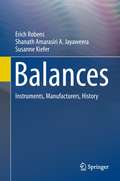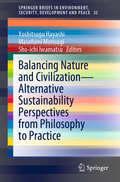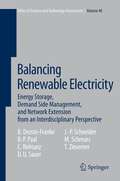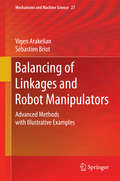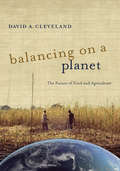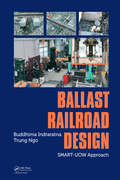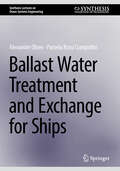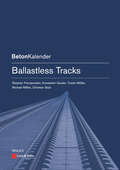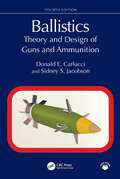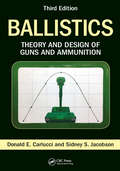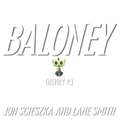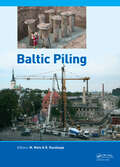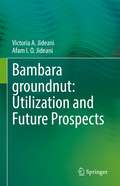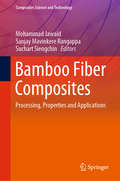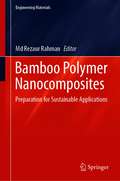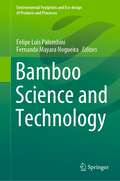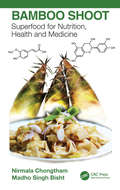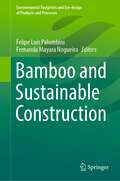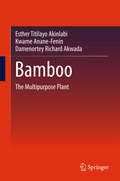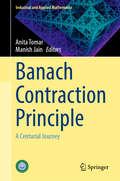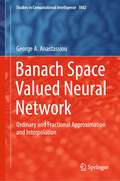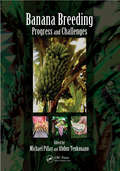- Table View
- List View
Balances: Instruments, Manufacturers, History
by Erich Robens Shanath Amarasiri A. Jayaweera Susanne KieferThe book deals mainly with direct mass determination by means of a conventional balances. It covers the history of the balance from the beginnings in Egypt earlier than 3000 BC to recent developments. All balance types are described with emphasis on scientific balances. Methods of indirect mass determination, which are applied to very light objects like molecules and the basic particles of matter and celestial bodies, are included As additional guidance, today's manufacturers are listed and the profile of important companies is reviewed. Several hundred photographs, reproductions and drawings show instruments and their uses. This book includes commercial weighing instruments for merchandise and raw materials in workshops as well as symbolic weighing in the ancient Egyptian's ceremony of 'Weighing of the Heart', the Greek fate balance, the Roman Justitia, Juno Moneta and Middle Ages scenes of the Last Judgement with Jesus or St. Michael and of modern balances. The photographs are selected from the slide-archives of the late Richard Vieweg (1896-1972) (former President of the Physikalisch-Technische Bundesanstalt, Braunschweig, Germany), of the late Hans R. Jenemann (1920-1966) (former head of the Analytical Laboratory of Schott & Gen. , Mainz, Germany) and of his wife Irene (1933-2008) and of Erich Robens.
Balancing Nature and Civilization - Alternative Sustainability Perspectives from Philosophy to Practice (SpringerBriefs in Environment, Security, Development and Peace #32)
by Yoshitsugu Hayashi Masafumi Morisugi Sho-Ichi IwamatsuThis book is an outcome of an international symposium: Sustainability –Can We Design the Future of Human Life and the Environment? which was held as a satellite event of the “Love the Earth”-Expo 2005 (Aichi, Japan). Each chapter is based on the lecture given by the following eminent researchers: Yoshinori Ishii, Hans-Peter Dürr, Yoshinori Yasuda, Minoru Kawada, Yasunobu Iwasaka, Werner Rothengatter, Hisae Nakanishi, Yang Dongyuan, Lee Schipper, Itsuo Kodama, and Yoshitsugu Hayashi.In the Part I titled “A Sustainable Relationship between Nature and Humans”, we discuss what will become of fossil fuels and petroleum, and what kind of indicators should be used to monitor the energy expended by human society. We then discuss environmental impacts caused by different civilizations and values on Nature and ethics, based on the perspective of environmental archaeology and on the discussions by Kunio Yanagita, the father of Japanese folklore study.The Part II is titled and shows “International Conflict Concerning Environmental Damage and Its Causes”. The Asian dust (Kosa) is a typical example of transboundary conflicts between nations. Another example can be found in the EU’s attempt to put in place a common motorway toll system across EU countries having different geographical and economic conditions. Finally, Part III covers the opinions and further debates on sustainable future earth based on the lectures in Parts I and II.We hope that great insights in this book will come across to readers, and be of help in steering the world towards a sustainable society in harmony with biosystems on earth.
Balancing Renewable Electricity: Energy Storage, Demand Side Management, and Network Extension from an Interdisciplinary Perspective (Ethics of Science and Technology Assessment #40)
by Christian Rehtanz Bert Droste-Franke Jens-Peter Schneider Miranda Schreurs Dirk Uwe Sauer Thomas Ziesemer Boris P. PaalAn important aim behind the restructuring of Germany's and Europe's electricity systems is to reduce the environmental burden, especially with respect to greenhouse gas emissions, of the current systems. Emissions must be brought down to a level that is sustainable in the long run and consistent with greenhouse gas emission reduction goals. Meeting these goals will require a system (as best as current knowledge suggests) that will be able to cope simultaneously with the fundamental demands for economic efficiency, environmental sustainability and supply security. Making use of existing scenarios, this study sketches such a system. It focuses in particular on auxiliary systems such as energy storage methods and network extensions. The study introduces technologies that can balance electricity in energy systems and that can serve as enabling technologies for the integration of large quantities of renewable energies in the power supply system. It begins with a discussion of normative aims for the future electricity system before continuing with a description of current policies and political developments and an overview of relevant existing energy system studies. These sections serve as background for the remainder of the study. They are followed by discussion and analysis of the growing demand for means to balance the fluctuations found in electricity generated in power systems with a high penetration of renewable energies, the potentials of diverse technologies, requirements for electrical networks, economic impacts and important legal issues. Finally, the main challenges to the achievement of developing balancing technologies and processes for renewable electricity-dominant systems are summarised and recommendations made.
Balancing of Linkages and Robot Manipulators: Advanced Methods with Illustrative Examples (Mechanisms and Machine Science #27)
by Vigen Arakelian Sébastien BriotIn this book advanced balancing methods for planar and spatial linkages, hand operated and automatic robot manipulators are presented. It is organized into three main parts and eight chapters. The main parts are the introduction to balancing, the balancing of linkages and the balancing of robot manipulators. The review of state-of-the-art literature including more than 500 references discloses particularities of shaking force/moment balancing and gravity compensation methods. Then new methods for balancing of linkages are considered. Methods provided in the second part of the book deal with the partial and complete shaking force/moment balancing of various linkages. A new field for balancing methods applications is the design of mechanical systems for fast manipulation. Special attention is given to the shaking force/moment balancing of robot manipulators. Gravity balancing methods are also discussed. The suggested balancing methods are illustrated by numerous examples.
Balancing on a Planet
by David A. ClevelandThis book is an interdisciplinary primer on critical thinking and effective action for the future of our global agrifood system, based on an understanding of the system's biological and sociocultural roots. Key components of the book are a thorough analysis of the assumptions underlying different perspectives on problems related to food and agriculture around the world and a discussion of alternative solutions. David Cleveland argues that combining selected aspects of small-scale traditional agriculture with modern scientific agriculture can help balance our biological need for food with its environmental impact--and continue to fulfill cultural, social, and psychological needs related to food. Balancing on a Planet is based on Cleveland's research and engaging teaching about food and agriculture for more than three decades. It is a tool to help students, faculty, researchers, and interested readers understand debates about the current crisis and alternatives for the future.
Balkan Cyberia: Cold War Computing, Bulgarian Modernization, and the Information Age behind the Iron Curtain
by Victor PetrovHow Bulgaria transformed the computer industry behind the Iron Curtain—and the consequences of that transformation for a society that dreamt of a brighter future.Bulgaria in 1963 was a communist country led by a centralized party trying to navigate a multinational Cold War. The state needed money, and it sought prestige. By cultivating a burgeoning computer industry, Bulgaria achieved both but at great cost to the established order. In Balkan Cyberia, Victor Petrov elevates a deeply researched, local story of ambition into an essential history of global innovation, ideological conflict, and exchange. Granted tremendous freedom by the Politburo and backed by a concerted state secret intelligence effort, a new, privileged class of technical intellectuals and managers rose to prominence in Bulgaria in the 1960s. Plugged in to transnational business and professional networks, they strove to realize the party&’s radical dreams of utopian automation, and Bulgaria would come to manufacture up to half of the Eastern Bloc&’s electronics. Yet, as Petrov shows, the export-oriented nature of the industry also led to the disruption of party rule. Technicians, now thinking with and through computers, began to recast the dominant intellectual discourse within a framework of reform, while technocratic managers translated their newfound political clout into economic power that served them well before and after the revolutions of 1989.Balkan Cyberia reveals the extension of economic and political networks of influence far past the reputed fall of communism, along with the pivotal role small countries played in geopolitical games at the time. Through the prism of the Bulgarian computer industry, the true nature of the socialist international economy, and indeed the links between capitalism and communism, emerge.
Ball Redbook: Crop Culture And Production
by Jim Nau Bill Calkins Allison WestbrookThis essential resource for professional plant growers includes techniques and advice intended for real-world greenhouse and nursery production. Information is offered on the basics of crop culture—media, nutrition, irrigation, water quality, light, temperature, crop scheduling, growth regulators, pest management, and more. In the Crops section, which is organized by botanical name, you will find details about propagation, growing on, insect and disease control, troubleshooting, and postharvest care. The plants represented in this compendium include annuals, perennials, flowering potted plants, herbs, vegetable bedding plants, and a new and detailed section on cannabis/hemp.
Ballast Railroad Design: Smart-uow Approach
by Buddhima Indraratna Trung NgoThe rail network plays an essential role in transport infrastructure worldwide. A ballasted track is commonly used for several reasons, including economic considerations, load bearing capacity, rapid drainage and ease of maintenance. Given the ever-increasing demand for trains to carry heavier axle loads at greater speeds, traditional design and construction must undergo inevitable changes for sustainable performance. Ballast is an unbounded granular assembly that displaces when subjected to repeated train loading affecting track stability. During heavy haul operations, ballast progressively deteriorates and the infiltration of fluidized fines (mud pumping) from the underlying substructure and subgrade decreases its shear strength and also impedes drainage, while increasing track deformation and associated maintenance. Features: serves as a useful guide to assist the practitioner in new track design as well as remediating existing tracks. research discussed in this book has made considerable impact on the railway industry. resulting from collaborative research between academia and industry, incorporating sophisticated laboratory tests, computational modelling and field studies. This book presents a comprehensive procedure for the design of ballasted tracks based on a rational approach that combines extensive laboratory testing, computational modelling and field measurements conducted over the past two decades. Ballast Railroad Design: SMART-UOW Approach will not only become an imperative design aid for rail practitioners, but will also be a valuable resource for postgraduate students and researchers alike in railway engineering.
Ballast Water Treatment and Exchange for Ships (Synthesis Lectures on Ocean Systems Engineering)
by Alexander Olsen Pamela Rossi CiampoliniThe inadvertent transfer of harmful aquatic organisms and pathogens in the ballast water of ships has been determined to have caused a significant adverse impact to many of the world's coastal regions. The international maritime community, under the auspices of the IMO has developed several documents, including the “International Conventions for the Control and Management of Ship's Ballast Water and Sediments, 2004”, (Ballast Water Management Convention), which are aimed at preventing the introduction of unwanted aquatic organisms and pathogens through the discharge of ballast water and sediments. The Ballast Water Management Convention applies to vessels registered in a country which is party to the Convention and to those vessels registered in other countries when operating in the waters of a country which is party to the Convention. As a means to prevent, minimize and ultimately eliminate the risk to the environment, human health, property and resources arising from the transferof harmful aquatic organisms and pathogens through the control and management of vessel's ballast water and sediment, as well as to avoid unwanted side-effects from that control, the Convention requires vessels to conduct a ballast water exchange or be fitted with an approved ballast water management system. It is noted that several studies have shown that the effectiveness of ballast water exchange varies and is dependent on the vessel type (design), exchange method (sequential, flow-through and dilution methods), ballasting system configuration, exchange location, weather conditions and vessel's trading pattern. For these reasons (and others), it has been determined that ballast water exchange does not provide adequate protective measures to prevent damage from organisms and pathogens carried in a vessel's ballast, even though exchange was considered to be acceptable as an interim solution.This book includes updates for the clarification of Survey requirements and adds the definition of biological commissioning, testing as well as requirements for Class approved Service Providers to conduct biological commissioning testing. Moreover, this book includes updates due to the adoption of the requirements from IACS UR M74, Rev. 2 and UR F45 and is applicable for existing ships, where an application for approval for the plans of BWMS is made on or after 1 July 2022; or for new ships contracted for construction on or after 1 July 2022.
Ballastless Tracks (Beton-Kalender Series)
by Stephan Freudenstein Konstantin Geisler Tristan Molter Michael Missler Christian StolzDue to increasing traffic flows the extension of transport infrastructure with rail roads and high speed lines is an ongoing process worldwide. Ballastless track systems with concrete slabs are used more and more. Following the first trials in the 1970s and more than four decades of R&D work on ballastless track, the level of development is such that it can be confirmed that ballastless track is suitable for use as an alternative to ballasted track. This book makes a contribution to the state of the art of ballastless track by describing the basics for designing the ballastless track. Important advice is provided regarding the construction of ballastless track on earthworks and in tunnels. There is also a description of the technical history of the development of ballastless track on bridges and the ensuing findings for bridge design. The state of the art of ballastless track for switches, important information on details concerning drainage, transitions, accessibility for road vehicles and experience gleaned from maintenance round off the work. Selected chapters from the German concrete yearbook are now being published in the new English "Beton-Kalender Series" for the benefit of an international audience. Since it was founded in 1906, the Ernst & Sohn "Beton-Kalender" has been supporting developments in reinforced and prestressed concrete. The aim was to publish a yearbook to reflect progress in "ferro-concrete" structures until - as the book's first editor, Fritz von Emperger (1862-1942), expressed it - the "tempestuous development" in this form of construction came to an end. However, the "Beton-Kalender" quickly became the chosen work of reference for civil and structural engineers, and apart from the years 1945-1950 has been published annually ever since.
Ballistics: Theory and Design of Guns and Ammunition
by Donald E. Carlucci Sidney S. JacobsonBallistics examines the analytical and computational tools for predicting a weapon’s behavior in terms of pressure, stress, and velocity, demonstrating their applications in ammunition and weapons design. It includes updated and revised equations, end-of-chapter problems, case studies, and practical examples.Explaining the physics of a gun launch, the book describes the behavior of the propelling charge that moves the projectile through the gun tube and the necessary methods to calculate how the projectile will fly. The new edition features a new chapter on closed vessel experimentation and analysis, which discusses closed bomb testing to incorporate new propellants into interior ballistics designs. It covers the mathematical fundamentals that are key to developing a safe and reliable gun system.With its thorough coverage of interior, exterior, and terminal ballistics, this new edition continues to be the standard resource for ballistics experts and researchers studying the technology of guns and ammunition and designing state-of-the-art propellants.Instructors will be able to utilize a Solutions Manual and Figure Slides for their course.
Ballistics: Theory and Design of Guns and Ammunition, Third Edition
by Donald E. Carlucci Sidney S. JacobsonWith new chapters, homework problems, case studies, figures, and examples, Ballistics: Theory and Design of Guns and Ammunition, Third Edition encourages superior design and innovative applications in the field of ballistics. It examines the analytical and computational tools for predicting a weapon’s behavior in terms of pressure, stress, and velocity, demonstrating their applications in ammunition and weapons design. New coverage in the Third Edition includes gas-powered guns, and naval ordinance. With its thorough coverage of interior, exterior and terminal ballistics, this new edition continues to be the standard resource for those studying the technology of guns and ammunition.
Baloney (Henry P.)
by Jon ScieszkaThe twisted team that gave the world Squids Will Be Squids and The Stinky Cheese Man now delivers a whole lot of Baloney. <P><P> Henry is an alien schoolkid who needs to come up with one very good excuse to explain why he is late for szkola, again. Otherwise, his teacher Miss Bugscuffle promises, it's Permanent Lifelong Detention. Henry's tall tale of his lost zimulis-received from deep space by Jon Scieszka-is told in at least twenty different Earth languages and graphically recreated in Lane Smith's out-of-this-world illustrations. The unbelievable trip into Henry's wild universe may be the most original excuse ever for being late for szkola. Or it might just be Baloney.
Baltic Piling
by M. Mets R. Raudsepp'Baltic Piling' contains the proceedings of theBaltic Piling Days 2012 (Tallinn, Estonia, 3-5 September 2012). The book includes contributions on current issues in pile foundation engineering:- Interaction of pile and grillage;- Formation of pile bearing capacity- Settlements of piles- Pile foundation under historical buildings- Thermopiles, and
Bambara groundnut: Utilization and Future Prospects
by Victoria A. Jideani Afam I. JideaniThe Bambara groundnut (BGN) or Vigna subterranea is an extremely hardy grain legume. As it produces reasonable yields even under conditions of drought and low soil fertility, it is also a climate-smart crop. Previously underutilized, BGN is the subject of growing interest among researchers and consumers for its balanced nutritional profile. Indigenous consumers of BGN report medicinal benefits from the plant; however, such knowledge is at risk of being lost with the urbanization and changing lifestyles of younger generations. To date, there is no comprehensive resource on the Bambara groundnut, despite market demand for plant proteins around the globe. Authored by scientists who have researched and developed patents using BGN, Bambara Groundnut: Utilization and Future Prospects aims to fill this gap. The text provides in-depth coverage on breeding, food and feed utilization, medicinal benefits and future research prospects. Drawing on both indigenous knowledge and cutting-edge research, Bambara Groundnut is the first book to fully explore the potential of this remarkable crop.
Bamboo Expansion: Processes, Impacts, and Management
by Ling ZhangThis book highlights processes, impacts and management practices of bamboo expansion occurring in areas where it is distributed around the world. Although not conceptually plant invasions, bamboo expansion has been considered an “invasion” based on its characteristics and the impacts it caused on adjacent ecosystems it expanded into, including altered element cycling, transformed soil microbial community compositions, decreased biodiversity, fluctuated primary productions, etc. However, the processes and impacts during or after complete expansion and the underlying mechanisms of successful expansion, are still unclear. The ecological effects of bamboo expansion are not given full consideration and are not thoroughly understood. Based on the latest studies, this book synthesizes research progress of bamboo expansion effects on the soil abiotic environment, soil microbial community compositions, plant characteristics, ecosystem biodiversity, element cycling process, and ecological effects of primary management practice, etc. This book will provide a thorough understanding of ecological changes following bamboo expansions, benefit the effective control of expanding bamboo with respect to decreased biodiversity and mitigation of global change, and accurate prediction and evaluation of bamboo expansion impacts currently and in the future occur around the world. This book presents critical points that need further investigation based on the latest findings, which will be helpful for ecological researchers, policymakers, forestry workers, or graduate and PhD students.
Bamboo Fiber Composites: Processing, Properties and Applications (Composites Science and Technology)
by Mohammad Jawaid Suchart Siengchin Sanjay Mavinkere RangappaThis book summarizes many of the recent developments in the area of bamboo composites with emphasis on new challenges for the synthesis characterization, properties of bamboo composites and practical applications. The book provides an update of all the important areas of (synthesis, processing, properties and application) bamboo fibers and its composites in a comprehensive manner. The chapters contributed by leading researchers from industry, academy, government and private research institutions across the globe benefit academics, researchers, scientists, engineers and students in the field of natural fiber composites.
Bamboo Polymer Nanocomposites: Preparation for Sustainable Applications (Engineering Materials)
by Md Rezaur RahmanThis bookshows how to enhance somebamboopropertiesandthesurface treatmentsforobtaininghigh strength nanocomposites. It describes the tensile, flexural and impact strength, surface behaviour, morphological analysis, infrared spectral functional analysis and thermal properties analysis of manufacture nanocomposites. It also investigates the optimization of fabrication techniquesto prepare bamboo nanocomposites reinforcedwithvarious polymers. The book alsodescribesenvironmental impact analysis of bamboo nanocomposites. This book concludes with the nano-enhancement on bamboo species to produce nanocomposites and possibleusage of nanocomposites materials in terms of sustainability and economics.
Bamboo Science and Technology (Environmental Footprints and Eco-design of Products and Processes)
by Felipe Luis Palombini Fernanda Mayara NogueiraBamboo is one of the most sustainable materials in nature due to its fast growth, rapid regeneration, outstanding mechanical properties, and applications in numerous industries. Latest technological advances have been allowing the plant to be studied and applied to exciting new projects. Being bamboo an icon of sustainable development, this book approaches the latest developments in the study of the plant, either as a natural resource or as a source of inspiration for more efficient designs. With the global urging demand for more sustainable practices, innovations in bamboo science and technology are key to the development of environmentally sound solutions.
Bamboo Shoot: Superfood for Nutrition, Health and Medicine
by Nirmala Chongtham Madho Singh BishtBamboo is an ordinary plant with extraordinary properties. With its high growth rate and self-renewing ability, bamboo’s sustainability is unparalleled. Bamboo is an important resource for a healthy planet, and its shoots hold manifold nutritional benefits. Based on 18 years of research, Bamboo Shoot: Superfood for Nutrition, Health and Medicine details health-promoting bioactive compounds found in bamboo and offers practical guidance on how this vegetable, bamboo shoot, is used for food fortification. Already a delicacy in many Asian countries, bamboo shoots aid in the prevention of cardiovascular disease, cancer, diabetes, hypertension and obesity. Exploring the tradition and culture of bamboo in Asian countries, this book also provides information on the science behind the nutritional value of bamboo shoots. Written by individuals with expertise in bamboo shoot nutrition and fully illustrated in colour, this book reveals the antioxidant activity of bamboo shoots and discusses the potential for bamboo to be used as an ingredient in functional foods and nutraceuticals. This highly practical book discusses processing and packaging of shoots for long term storage and using bamboo in the development of novel food products. Features: Elucidates the nutrients and phytochemicals in over 30 bamboo species and includes a glossary of scientific names Highlights the nutraceutical and antioxidant properties of bamboo Describes novel healthy food products fortified with bamboo shoots and provides food recipes using bamboo Explains how bamboo can help countries achieve their sustainable development goals, from poverty reduction, food security, improved nutrition and prevention of diseases to climate change mitigation and inclusive green economic development Aimed at professionals in the nutrition and food processing industry, this book appeals to those with an interest in incorporating bamboo into a healthier lifestyle. Endorsements This is a unique book interestingly crafted to highlight the important nutritional, health and medicinal aspects of Bamboo, an area that is greatly underexplored. It will bring awareness that bamboo shoots are a low calorie, high fibre nutritious vegetable packed with vitamins and minerals. - Prof. Cherla Sastry, Founding Director General INBAR and Adjunct Professor, University of Toronto, Canada This book brings a series of answers to all questions related to bamboo as a superfood [and will] enlighten readers how to transform bamboo shoots using either traditional or modern techniques, how to package them and how to use them as a functional and nutraceutical food. It also provides a series of cooking recipes for healthy eating while we enjoy our food. - Ximena Londoño, Founder, A Bamboo and Guadua Paradise, Colombia
Bamboo and Sustainable Construction (Environmental Footprints and Eco-design of Products and Processes)
by Felipe Luis Palombini Fernanda Mayara NogueiraBamboo is considered one of the most sustainable and versatile building materials, driving the development of multiple techniques for its study and utilization. With new techniques to better analyze, comprehend, and exploit its uses, the plant can be used in numerous applications. From direct building material to composites, this book explores the latest developments in the application of bamboo in the sustainable construction industry.
Bamboo: The Multipurpose Plant
by Esther Titilayo Akinlabi Kwame Anane-Fenin Damenortey Richard AkwadaThis book is intended for use both in the industry and the academia. It introduces the physical, chemical and the mechanical properties as well as the characterization of bamboo. Novel industrial applications in structural, non-structural, reinforcement, afforestation, land reclamation, environmental significance, textile, medical, geotechnical, hydraulic, food, pulp and the paper industries are addressed in detail. Bamboo has been used for centuries as a structural material as well as in diverse engineering applications, food and medicinal purposes, especially in Asia. As a natural fiber composite, bamboo has the potential for many developments in academic and industrial research. Current literature on composites tends to focus on bamboo as a plant or solely as a structural engineering material. This book seeks to bring together these two extremes and provides a holistic resource on the subject.
Banach Contraction Principle: A Centurial Journey (Industrial and Applied Mathematics)
by Manish Jain Anita TomarThis book offers a comprehensive exploration of the Banach contraction principle and its many facets. A compilation of chapters authored by global experts, it is aimed at researchers and graduate students in mathematics. The content covers the Banach contraction principle, its generalizations, extensions, consequences and applications, focusing on both single-valued and multi-valued mappings across various spaces. While discussing theoretical foundations, this book uniquely emphasizes the practical applications of the Banach contraction principle in real-world problem-solving scenarios. Each chapter addresses specific topics, including fractals, fractional differentials, integral equations, elastic beam problems and mathematical modeling and analysis of electrical circuits. These diverse subjects showcase the principle&’s versatility in solving complex issues that go beyond theoretical mathematics. By highlighting Banach&’s contraction principle as a lasting legacy, the book not only honours past mathematical achievements but also anticipates future innovations in industrial and applied mathematics. It underscores the enduring relevance of the principle, ensuring its continued prominence in mathematical discourse and its pivotal role in driving advancements across the field. This comprehensive exploration catalyzes inspiring future developments in mathematical research.
Banach Space Valued Neural Network: Ordinary and Fractional Approximation and Interpolation (Studies in Computational Intelligence #1062)
by George A. AnastassiouThis book is about the generalization and modernization of approximation by neural network operators. Functions under approximation and the neural networks are Banach space valued. These are induced by a great variety of activation functions deriving from the arctangent, algebraic, Gudermannian, and generalized symmetric sigmoid functions. Ordinary, fractional, fuzzy, and stochastic approximations are exhibited at the univariate, fractional, and multivariate levels. Iterated-sequential approximations are also covered. The book’s results are expected to find applications in the many areas of applied mathematics, computer science and engineering, especially in artificial intelligence and machine learning. Other possible applications can be in applied sciences like statistics, economics, etc. Therefore, this book is suitable for researchers, graduate students, practitioners, and seminars of the above disciplines, also to be in all science and engineering libraries.
Banana Breeding: Progress and Challenges
by Michael Pillay Abdou TenkouanoWith the current world population growth of 1.2%, the earth can expect to house 9-10 billion people by 2050. Food production, too, must increase to accommodate these numbers. Easy growing, high calorie, nutritious foods, such as bananas are the top priority as a solution to this imminent problem. The first comprehensive compendium on bananas in rec
